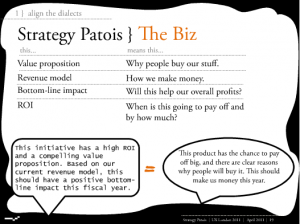Just last week the UX team at Caplin had the fortune of attending UX London 2011, the largest UX conference in the UK, for three days of talks and workshops. Some of the biggest names in the industry from all over the world came and shared their insights. It was a great opportunity to meet with fellow UXers and learn about their trials and triumphs.
Here are our top 3 highlights.
1. We Need A Common Language To Communicate

In many companies, there seems to be an issue of miscommunication, particularly amongst designers, developers and business folk. There is the confusion of “what we said, what he expected” and the end result which is normally nonsense. Dependent on your career you may use different jargon, buzzwords, delivery styles and have different ideas of what are the important aims and goals.
In order to overcome this gap of understanding, we need to “align the dialects”, as Kate Rutter says. By this she means that we need to demystify our different vocabularies and clarify their meanings to each other in simple terms. As designers we need to express our strategy and its impact on business through using certain “strategy tools “ such as the Ishikawa diagram, prioritisation charts, storyboards, conversion models and product evolution maps. These tools allow the business people to understand our approach and help reinforce decisions. Having an insider who can appreciate the perspectives of your business colleagues will help bridge the gap between the languages and establish expectations. Finally addressing key points with short, concise answers removes the extra jargon while getting across the underlying ‘What’ and ‘Why’ behind a design.
(For Kate’s full presentation check out on ‘Strategy Patois’)
2. Redesign Must Die
Louis Rosenfeld gave a great talk about how we should never “redesign” a website, software application or digital interface as it is a hollow, meaningless and vain pursuit.

By this he means that simply giving an interface a new look will never weed out the original problems it had, as this can only be achieved through understanding interface users’ needs and designing to address these. He said that ill-defined problems cause “insanity and vanity” as they cause the user (and the designer!) to have a painful experience and only focus on the surface. In order to avoid doing redesign we should:
- Prioritise – regularly identify the most important problems to our users
- Tune – incrementally address those problems
- Be opportunistic – Look for simple ways you can make a difference now, such as supporting contextual navigational needs of users or improving search results to be ‘smarter’ according to users’ needs
(For Louis’ full presentation check out ‘Redesign Must Die’)
3. Changing A Company’s Culture Is Difficult
This point came from Kim Goodwin’s Leading UX presentation which covered the core skills a good UX team leader should have as well as how to make changes internally in your company. The overall message was that the two things that companies that deliver great experience have in common is: 1. Great Leadership and 2. A Culture That Supports Change.
A ‘good leader’ will be able to deliver feedback, handle criticism, negotiate, and mediate conflicts.

A culture that supports change will be full of people that share the same vision and values. It will also be adaptive, accepting of risk & failure, committed to quality and willing to prioritise. If a company is lucky enough to have both of these, it will take a minimum of 3-5 years for the change to emerge in a noticeable way. The reason for this is that old cultures have deep roots and without full commitment from the entire organisation, change is improbable. However, if you are determined to bring about positive changes in your organisation, the steps to take are:
- Establish Urgency
- Develop A Guiding Coalition
- Develop A Vision
- Communicate The Vision
- Enable Action
- Get Short-Term Wins
- Don’t Let Up
- Make Change Stick
(For Kim’s full presentation check out ‘Leading UX’)
For other exciting UX events around the world check out FindUXEvents.com and Johnny Holland’s UX Calendar for listings!


